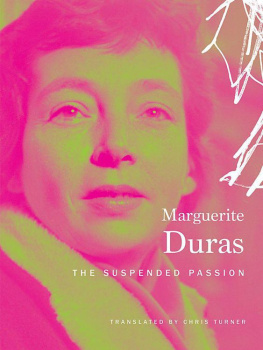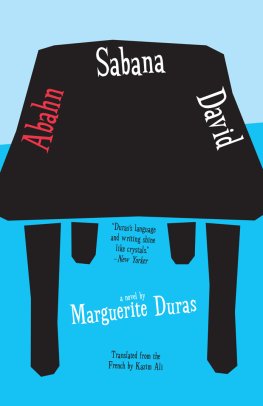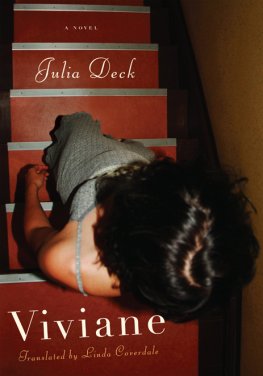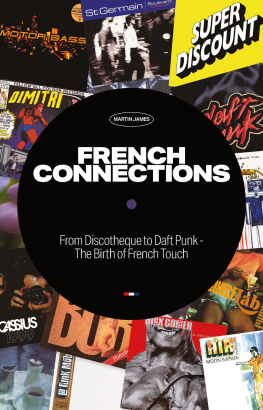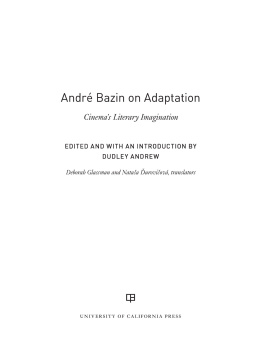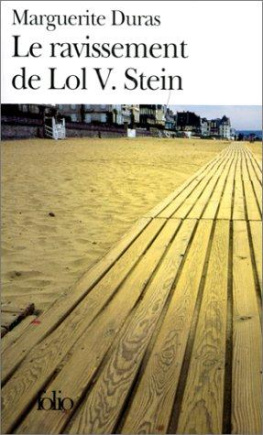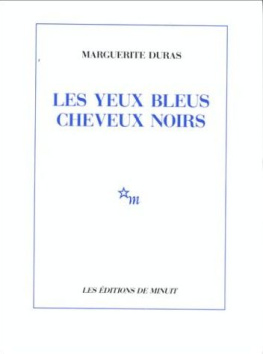.
.
.
.
.
.
.
.
I met Marguerite Duras for the first time in 1987, shortly after the Italian translation of Blue Eyes , Black Hair was published.
Getting that interview for La Stampa wasnt very easy.
To persuade her to do it, I had to call several times and haggle. She seemed in a state of weary indifference. Saying she had flu and complaining of a heavy workload (I discovered later that she was working on the screenplay of The Lover ), she declined my invitation. Then, one afternoon, I mentioned my friendship with Inge Feltrinelli. Thrown for a moment by that, she came back with: Get her to call me right away. I rang Inge and begged her to call Duras. Half an hour later, I was inexplicably granted a meeting.
I turned up at rue Saint-Benot a little ahead of time. The third-floor landing was tiny and poorly lit. I rang, but had to wait a few minutes before a male voice from behind the door (I immediately thought of Yann Andra, the man she had been living with for nine years) suggested that I go and get a coffee in the caf on the ground floor of the building and not come back for at least half an hour. From deep within the flat I heard Marguerites voiceshe was claiming she had forgotten this appointment for our interview.
Returning at the time specified, I was admitted to find her with her back to me. She was small, very small, and seated, as ever, in her dusty bedroom cluttered with papers and objects, her elbows propped on her writing table.
She stared at me in silence, not taking the slightest notice of what I was saying. Then she began to speak, painstakingly adopting that extraordinary timbre she is able to assume, modulating her tone and her pauses. From time to time she stopped, with some irritation, to clarify the words I had taken down in my notebook. And as soon as the telephone rang, she clasped my hand, clamping it in her own to prevent me from transcribing even a single word she spoke.
The whole time I was with her (three hours, perhaps more), she was constantly pulling large mints out of a drawer, choosing only at the end to offer me one.
When we were done, she even agreed to be photographed. Dressed in her usual Marguerite Duras uniformshort, flared skirt, roll-neck pullover, black waistcoat, platform shoesshe turned around slowly to pose. It was as if she were defying the lens, ensuring that her blue eyes were in the picture, as well as the precious rings bedecking her fingers.
As I was leaving, I asked her if I could come back. Do as you like, she said, but I dont have much time.
I leant over to say goodbye and she kissed me.
As soon as I returned to Paris after the summer, I called her. I explained that Id brought a nice piece of Parmesan back from Italy for her. It was noon and Marguerite had just got up. Good, she said, as it happens, I had nothing to eat in the house.
She suggested that I come over in a few minutes. However, on this occasion too, she wasnt the one who answered the door. As for the shy, conscientious Yann, he simply took my heavy package from me and as quickly closed the door in my face.
I realized that it wasnt the moment to press matters and I let a few days go by.
Long afternoons of chatting and conversation followed in that collusive intimacy that (perhaps inevitably) develops over time between two women.
It was in this way that our talkher elliptical remarksemerged, at times without any clear connection, to be re-organized and re-ordered subsequently. Then it would go on, interminably, for hours. Until Marguerite peremptorily announced, Thats enough, now.
And, as though he had been waiting for the signal, Yann would enter from another room, offering as usual to take her for a walk, and delicately help her on with her strawberry-coloured coat.
As she spoke, Marguerite was constantly tugging at the crumpled white skin of her face, then smoothing it out. She would take off the pair of mens spectacles she had worn since her younger days, then put them back on again.
I listened to her remembering, thinking, letting go and gradually relinquishing her natural warinessegocentric, vain, stubborn, voluble. And yet capable, at times, of kind words and enthusiasms, of shyness, of suppressed and then uproarious laughter. She seemed suddenly fired with a consuming, voracious and almost childlike curiosity.
I can still remember the last time we met. As always, the television was on in another part of the living room and Marguerites face seemed tired, as though it had swelled in the course of a few days.
She wanted to know everything about me. She couldnt stop asking questionsI had to tell her about my life, my loves or talk at great length about my mother, as she had about hers. To the end, my mother will remain the maddest, most unpredictable of the people Ive met in my entire life, she tells me with an already distant smile.
Leopoldina Pallotta della Torre
.
.
.
.
.
.
.
.
FRENCH TRANSLATORS NOTE
It was more than fifteen years ago, when I read Angelo Morinos essay on Marguerite Duras Il cinese e Marguerite (Palermo: Sellerio, 1997), that I learnt of the existence of this interview which was then still unpublished in France. In fact, Angelo Morino quoted copiously from it and it was immediately apparent that it contained elements that hadnt been covered at such length in the various interviews published in French. The fact that Leopoldina Pallotta della Torre was Italian, her very determination and insistence, her thematic organization and her highly structured thinking prevented a certain indulgence and the evasions one finds in most of the interviews published hitherto, in which interviewers are often led, by their high-handed interlocutor, to speak Durasa coded language with which all her admirers, imitators and detractors are familiar, a language they variously caricature or practise and in which, most importantly, the many digressions and unfinished trains of thought at times render the dialogue borderline incoherent or, at any rate, divert it from the topic and leave it confused.
As for Angelo Morinos book, it was a study of the genesis of The Lover and a detailed comparison of the biographical elements scattered throughout Duras work, from The Sea Wall to Yann Andra Steiner , and supposedly new ones contributed by the novel that considerably widened the authors audience. It raised doubts about the late revelation made in that book regarding the identity of Huynh Thuy-L, the Chinese lover, who takes the place of The Sea Wall s Monsieur Jo. Comparing the three versions of the same events that Duras offers in The Sea Wall , The Lover and The North China Lover , stressing the difference in the number of brothers and, particularly, the identity of the lover (from the French Monsieur Jo, he becomes Huynh Thuy-L, a Vietnamese with a Chinese father) and attempting, above all, to explain the very longstanding concealment of the truth, he puts forward the idea that The Lover recounts an episode in the life of Marguerites mother, Marie Legrand, who is said, in his version, to have cheated on Henri (known as mile) Donnadieu with a Vietnamese or Chinese man. Marguerite and her youngest brother Paulo would then be the children of that lover (there are numerous allusions in The North China Lover to the lover, the daughter and the youngest son having similar skin). Pierre, by contrast, would be the only son of mile Donnadieu. This argumentthat the Lover is the mothers lover, not the daughtersis picked up by Michel Tournier in his book Clbrations . It is an argument that would almost be persuasive were it not for Marguerites physical resemblance to mile Donnadieu in the photographs the writer has made public. Marguerites gaze and the shape of her eyes come, in reality, from mile Donnadieu. And in June 1998, by which time Duras was dead, Danielle Laurin published in Lire magazine the story of her meeting with a former classmate of Duras, Mme Ly, at Sa Dec. She attests to Marguerites escapades with Huynh Thuy-L and states that in 1952, twenty years after Duras left Vietnam once and for all, she, Mme Ly, had received combs from Paris from her through Huynh Thuy-Ls sister-in-law, which would imply that the writer was still in touch with her Chinese loveror, at least, with his family. The house of Huynh Thuan, the lovers Chinese father, became a Lovers Museum in Sa Dec, though Duras never set foot in it. It is visited by tourists, who are also able to stay overnight.

